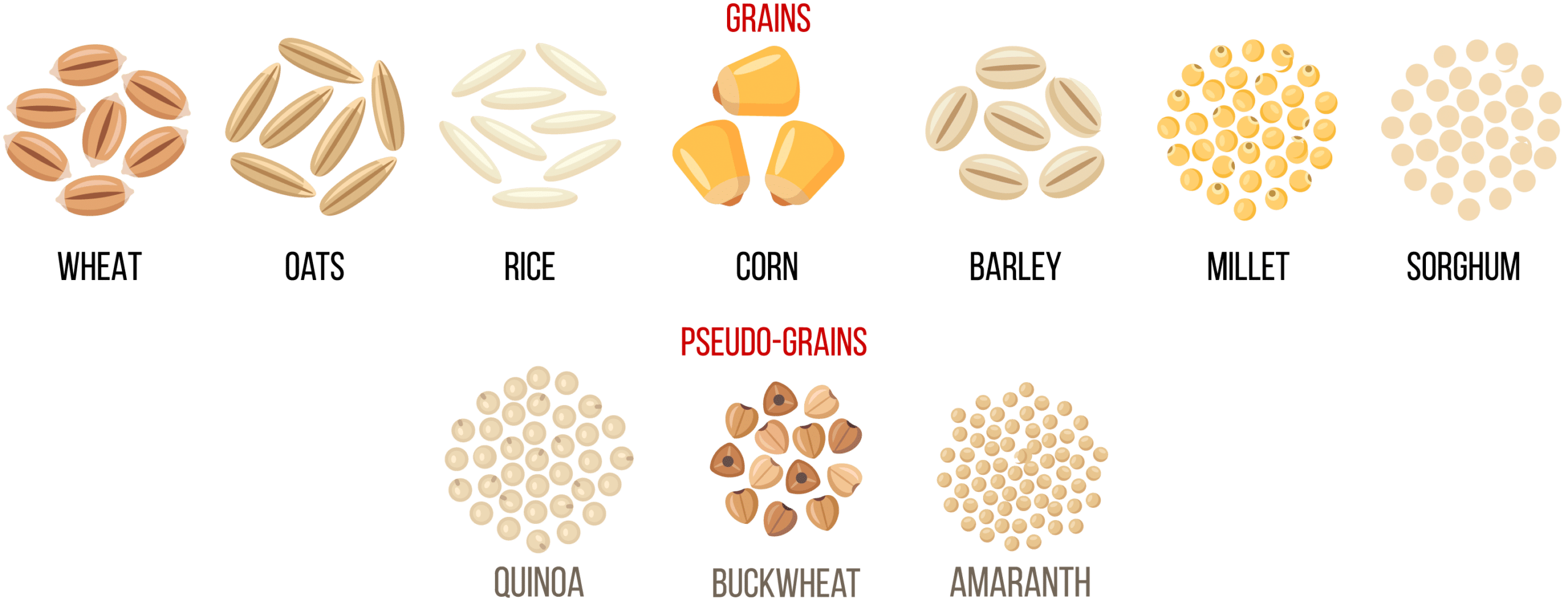Grains are the edible seeds of certain grasses.
Wheat, oats, rice, and corn are common grain foods, as are barley, spelt, millet and sorghum. Pseudo grains are foods that are not true grains may be similar in appearance and nutrition to true grains. Examples of pseudo grains are quinoa, buckwheat, and amaranth.

Are grain foods nutritious?
What’s the difference between refined grains and whole grains?
A grain is made up of three parts: the outer bran, the inner endosperm, and the germ which is like the heart of the grain. A whole grain includes all three of these parts, whether intact (such as brown rice) or ground into flour and then prepared in foods (such as whole-wheat bread). Whole grains would contain all the nutrients found in the grain kernel: fiber, B-vitamins, etc.
Refined grains contain only the endosperm, the starchy part that makes up about 80 percent of a grain. This part of the grain is a concentrated source of carbohydrates and protein, as well as some vitamins and minerals.
Enriched grains are refined grains that have vitamins and minerals added after the milling process. Most refined grains are enriched. This means certain B vitamins (thiamin, riboflavin, niacin, folic acid) and iron are added after processing. These grains have been fortified with nutrients that address specific public health needs like neural tube defects. Fiber is not always added back to enriched grains. Folic acid (folate) is not added to whole grains.
How Much Grain Should We Eat in a Day?
A person’s dietary needs depend on a variety of factors including age, weight, activity level and gender. Anywhere from 5-8 ounce-equivalents of grains is recommended for most children and adults. Younger children and older females need less, whereas males and the average adult need more.
An ounce-equivalent would be:
- 1 slice of bread
- 1 cup of ready-to-eat cereal
- ½ cup of cooked pasta or rice (1 ounce dry)
Of all the grain foods eaten in a day, at least half should come from whole grain sources.
Shouldn’t we be avoiding white bread and other refined enriched grains?
The Dietary Guidelines for Americans recommend getting at least half of your grains from whole grain sources. That’s because whole grains provide more fiber and some vitamins than refined grains, but that doesn’t necessarily mean that a diet must consist entirely of whole grains. Most refined grains are enriched with vitamins and minerals that both kids and adults need. In fact, it is mandatory in the United States that all refined wheat flour is fortified with folic acid as part of a public health effort to reduce neural tube defects which can occur in very early pregnancy – often before a woman even knows she’s pregnant. Since the folic acid fortification took effect, there has been a dramatic drop in cases of neural tube defects. Whole grain flours are not mandated to be fortified with folic acid, a B vitamin.
A healthy diet should include a mix of whole and refined grains. If a child or adult finds a whole grain food less palatable than its enriched counterpart, it’s perfectly OK to eat the refined grain version and find a different whole grain food to meet the half-whole-grains goal. For example, a child may prefer iron-fortified white bread over whole-grain bread for his sandwiches, but readily eat whole grain pasta with tomato sauce.
I get that I need grain foods, but should I focus more on brown rice, quinoa and other less processed grains and avoid prepared foods such as bread, cereal and pasta?
All grains deserve a place on the plate. Foods like bread, rolls, tortillas ready-to-eat cereals, and pasta contribute meaningful amounts of essential vitamins and minerals to the diets of Americans and are also associated with lower intake of saturated and total fat. It’s safe to say there is no need to eliminate certain grains – or any grains, that is – from your diet.
To be clear, the Dietary Guidelines for Americans only caution that grain products that are high in added sugars and saturated fats, such as cookies, cakes, and some snack foods, should be limited… but not eliminated. They can fit in healthy eating patterns.
